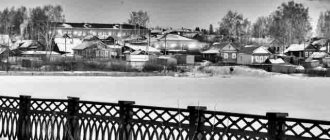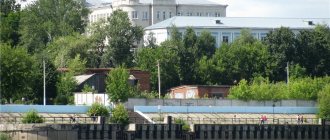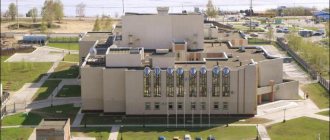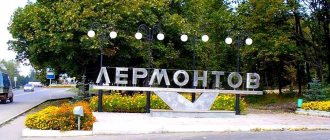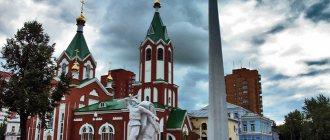Izhevsk
The Izhevsk workers' settlement was founded in 1760.
Since 1918 Izhevsk became a city. Since 1921 - the center of the Votsk Autonomous Region, since 1932 - the Udmurt Autonomous Region. Since 1934 - the capital of the Udmurt Autonomous Soviet Socialist Republic, since 1990 - the Udmurt Republic. In 1985-1987 it was called Ustinov.
Izhevsk today
Modern Izhevsk is a large industrial center, where more than half of Udmurtia's products are produced. The leading industries are metalworking and mechanical engineering, pigment metallurgy. The Izhevsk industrial complex is represented by 50 large enterprises of mechanical engineering, metallurgy, electronics, chemistry, etc. Among them are Izhmash OJSC, Bummash OJSC, Izhevsky Bearing OJSC, Izhevsky Moto OJSC, Izhevsky Mechanical State Enterprise, Izhstal OJSC, Izhevsky Radio OJSC and others.
Higher education institutions
Higher educational institutions of the city of Izhevsk are widely known for their academic traditions and high level of training of specialists: Udmurt State University and Izhevsk State Technical University, Izhevsk State Agricultural Academy and Izhevsk State Medical Academy and International East European University.
Culture
The theatrical art of Izhevsk is represented by the Udmurt Drama Theater and the Musical Theater of the Udmurt Republic (its repertoire includes performances in the national language of the Republic), the State Russian Drama Theater, the State Puppet Theater, the municipal theater "Young Man", a large number of youth and amateur studios.
In 2004, Izhevsk was recognized as the cultural capital of the Volga Federal District.
Administration of Izhevsk
Press service phone: 22-81-78, fax: 22-66-87, E-mail
Distinctive features and history of Udmurtia
Udmurtia is like Kazantip.
It’s also a republic, also part of Russia, and only strange people want to go there. One very funny man
According to some narrow-minded people, Udmurtia is something distant and dense, where shamans live, and every evening people bring gifts to the god of rain on the sacrificial altar. Not so. Udmurtia is not as far from Moscow as many might think. The capital of the republic, Izhevsk, is only 1200 km from the Mother See. In the evening you boarded the train, and in the morning you were already in Moscow.
The first permanent settlements on the territory of modern Udmurtia appeared 8-6 thousand years BC. Thanks to the excavations, the archaeologist was able to find out that at this place there were several cultures associated with the modern Udmurts - Chepetskaya, Polomskaya, Ananyinskaya and Pyanoborskaya (it seems that the Pyanoborskaya culture is still strong in Russia). At the turn of the 1st-2nd millennium AD, the Slavs called the Udmurts Votyaks or Otyaks (as they were called by those who could not pronounce the letter “v”).
Izhevsk Photo by Borisych (https://fotki.yandex.ru/users/kab-ts/)
The northern Udmurts were the first to join Russia; the southerners were still part of the Kazan Khanate, but Ivan the Terrible annexed everyone to his kingdom in one fell swoop. The Udmurts began to be baptized into Christianity en masse 2 centuries after the annexation. Only in 1731 was a commission of newly baptized affairs established, which operated on the territory of the Nizhny Novgorod and Kazan diocese, and massively converted the Udmurts to Orthodoxy.
Baptism had a negative impact on the people of Udmurtia. In 1774-1775, the Udmurts supported Emelyan Pugachev during the Peasant War. Further, until the beginning of the twentieth century, nothing interesting happened in the life of Udmurtia. Except that they founded a weapons production (the same one that gave the world the famous Kalashnikov assault rifle), and built a railway in 1899. In 1920, Lenin granted autonomy to the Udmurts. True, at first the territory was called the Votsk Autonomous Region (from the English What). In 1932, the Bolsheviks reached Udmurtia, and they renamed it again. This time to the Udmurt Autonomous Region.
Unfortunately, the Great Patriotic War gave impetus to the industrial development of Udmurtia. More than 40 enterprises were evacuated here. The famous one was built after the war, during the economic boom. In those years, new industries were opened everywhere in the country, and the Stakhanovites issued five times the norm per day.
The automobile plant in Izhevsk was built with the help of French specialists from Renault. The first car to roll off the IzhAvto assembly line was the famous Izh-Kombi, the first Soviet hatchback. Typically, the products of domestic car factories are famous not even for their poor build quality, but for the fact that they become obsolete even before the designers come up with them. Unfortunately, IzhAvto is no exception. Now the plant's facilities produce Russified foreign cars: Kia Sorento, Huyndai Elantra, Huyndai Sonata and others.
IzhAvto. Photo by yan-gorev (https://fotki.yandex.ru/users/yan-gorev/)
Geographical position
Udmurtia is located on the territory of the East European Plain, in the basins of the Kama and Vyatka rivers. From west to east the region stretches for 180 kilometers, and from north to south - 270. Udmurtia is part of the Volga Federal District. In the north and west, the republic borders on the Kirov region. In the east the neighbor is the Perm Territory, and in the south - Tatarstan and Bashkortostan.
Population
As many as 100 nationalities live in small Udmurtia. The majority of the republic's population is Russian. There are 62% of them. The Udmurts themselves are only 28%, Tatars - 7%. The remaining 3% of the total population accounts for 97 nations. In total, the region is home to 1,517,050 inhabitants, of which 65% are city dwellers. The average population density is 36.07 people/km2. There are few conflicts on ethnic grounds, since there are many Russians and the Udmurts do not want to argue with them. In general, outwardly, few people can distinguish an Udmurt from a Russian.
The cultural level of the residents of Udmurtia, unfortunately, leaves much to be desired. The republic is poor, about 20% of the local population is below the poverty line, and in such a situation there is absolutely no desire to talk about Shakespeare. The outskirts of Izhevsk, as well as all sorts of small settlements, are teeming with dubious personalities. It is better not to walk alone along the dark streets here. It's not safe for girls in the evenings either. There is even a joke: “The Miss Udmurtia competition ended in failure. The wolves came to the scent of the females.”
Izhevsk crocodile. Photo by borisbusorgin (https://fotki.yandex.ru/users/borisbusorgin/)
Crime
Udmurtia is a criminal region. It was like this in the 90s, and remains like this now. Due to the poverty of the residents, domestic crimes and ordinary traffic stops prevail. There are many drug addicts and drug dealers in the republic. For example, part of the drug traffic to the western regions of the country passes through Izhevsk. Drugs are mainly trafficked by Asians and visitors. Local bandits, who have become respectable people, are engaged in the collapse of enterprises.
Unemployment rate
The Udmurt industry is going through hard times. There are few jobs in factories. Some businesses have even switched to three- or four-day workdays to avoid paying people money for downtime.
If in production it is very difficult to find a good position with a good salary, then in trade there are a dime a dozen offers, however, most of them are designed for low-skilled labor. The average salary in the region is about 20 thousand rubles, but even that is not easy to earn. Most Udmurt employers pay wages to employees in envelopes.
Property value
Compared to neighboring regions, real estate in Udmurtia is inexpensive. Prices for one-room apartments in Izhevsk start from one and a half million rubles. A more or less decent living space can be purchased for 1,800 thousand rubles. In regional centers, for example, Sarapul, the cost of housing starts from a million rubles. For 500 thousand you can buy a hotel in a residential condition.
Climate
Due to the remoteness of the seas, the climate in Udmurtia is harsh. The region is characterized by hot summers and cold, snowy winters. The average annual temperature fluctuates around 1 °C. The absolute minimum registered on the territory of the Udmurt Republic is −50 °C. It was recorded in 1978. Negative temperatures in the region begin at the end of October and end at the beginning of April. There has been snow for almost five months.
Udmurt landscape. Photo by shandi (https://fotki.yandex.ru/users/shandi/)
Glazov
The city of Glazov is located in the north of Udmurtia, on the left bank of the Cheptsa. The village of Glazovo received city status in 1780.
Monuments
Within the city, in the Soldyr district, there is the largest archaeological monument of the Middle Ages (IX - XIII centuries) - the Idnakar settlement, which is under the protection of the Russian government and is of memorial value of world significance.
City plan
The master plan, unique in the history of Russian urban planning, developed by the famous St. Petersburg architect Ivan Lem, basically depicted the eye, or rather, the all-seeing eye of God. Such a rational-concentric layout went back to the type of “ideal city” of the Enlightenment. The architect repeated the idea of Versailles in this regard. Radial streets converged to a round central square - the “pupil”. The role of the upper “century” was played by the fortress wall (never built), and the lower one by the bend of the Cheptsa River.
Glazov today
Currently, none of the cities in Russia and Europe has similar urban planning analogues, and in Glazov the appearance of the city's development at the end of the 18th century has been preserved almost in its original form.
Now more than 100 thousand people live here.
Industry
Modern Glazov entered the new millennium as one of the largest cultural and industrial centers in the north of Udmurtia. The main industrial sectors are metallurgy, mechanical engineering, woodworking, and food industry.
The basis of the city’s industrial potential is the Chepetsk Mechanical Plant, the only enterprise in Russia and the world’s largest enterprise for the production of zirconium, uranium and calcium. OJSC Chepetsky Mechanical Plant occupies one of the key positions in Russia in the technological cycle of natural uranium and has modern technology for processing depleted uranium. One of the oldest enterprises in Udmurtia is a distillery whose products have been awarded many gold and silver medals at the most prestigious wine industry exhibitions in the world.
Address of the Glazov city administration:
427600 Udmurtia, Glazov, Dynamo St., 6, tel.: (34141) 4-13-00, 4-18-50, 3-66-65, E-mail
see also
- Udmurtia
- Cities of Russia
| [ + ] Cities by regions of Russia | |
| Cities of the North-West (NWFD) | St. Petersburg (and its cities) • Leningrad region (historical Staraya Ladoga) • Arkhangelsk region • Vologda region • Kaliningrad region • Karelia • Komi • Murmansk region • Nenets Autonomous Okrug • Pskov region |
| Cities of the Volga region (Volga Federal District) | Bashkortostan • Volgograd region • Kalmykia • Kirov region • Mari El • Mordovia • Nizhny Novgorod region • Orenburg region • Penza region • Perm region • Samara region • Saratov region • Tatarstan • Udmurtia • Ulyanovsk region • Chuvashia |
| Cities of Southern Russia (SFD) | Sevastopol (including Inkerman) • Republic of Crimea • Adygea • Astrakhan region • Krasnodar region • Rostov region |
| Cities of the North Caucasus (NCFD) | Dagestan • Ingushetia • Kabardino-Balkaria • Karachay-Cherkessia • North Ossetia - Alania • Stavropol Territory • Chechen Republic |
| Cities of the Urals (Ural Federal District) | Kurgan region • Sverdlovsk region • Tyumen region • Khanty-Mansi Autonomous Okrug - Yugra • Chelyabinsk region • Yamalo-Nenets Autonomous Okrug |
| Cities of Siberia (Siberian Federal District) | Altai Republic • Altai Territory • Irkutsk Region • Kemerovo Region • Krasnoyarsk Region • Novgorod Region • Novosibirsk Region • Omsk Region • Tomsk Region • Tyva • Khakassia |
| Cities of the Far East (FEFD) | Amur Region • Buryatia • Jewish Autonomous Region • Trans-Baikal Territory • Kamchatka Territory • Magadan Region • Primorsky Territory • Sakha (Yakutia) • Sakhalin Region • Khabarovsk Territory • Chukotka Autonomous Region |
| see also | Cities of the DPR, LPR, Transnistria, South Ossetia • Regions of Russia • Cities of Russia |
Kambarka
The city of Kambarka arose in 1761 as a settlement at the ironworks of G. Demidov. Located on the left bank of the Kama, eight kilometers from the port of the same name. The city has a developed transport communications system. A transport route passes through Kambarka; the transport port of Kambarka, which is a transshipment base for the Siberian Railway to the Kama River during the navigation period, is of great importance.
Kambarka today
The leading enterprises are OJSC Kambarsky Machine-Building, CJSC Metalist.
The population today is about 17 thousand people.
Natural resources
Not far from Kambarka there are reserves of lewisite, a type of chemical weapon that must be destroyed by the end of the first decade of the 21st century.
Address of the Kambarka city administration:
427950 Udmurtia, Kambarka, st. Sovetskaya, 18, tel/fax: (34153) 2-31-14
Kambarka as a center for the destruction of chemical weapons
The emergence of a large storage center for chemical toxic substances dates back to 1941, when chemical property base No. 136 of the State Vehicular Administration of the USSR NPO was located in Kambarka. In December 1941, the first shipments of lewisite, a poisonous gas with the smell of geranium, began to arrive at the site. In the 1950s stationary above-ground brick warehouses for storing chemical warfare agents are being built here. Five above-ground storage facilities with a concrete base were built, housing 80 metal tanks of 50 cubic meters each.
Mozhga
The city of Mozhga is located in the southwestern part of the Udmurt Republic on the Mozhginskaya Upland in the valley of the Syuginka River, a tributary of the Vala.
Location
The city of Mozhga appeared on the map in 1835 as a settlement at the Syuginsky glass factory. This is the only industrial center of southwestern Udmurtia. Today about 50 thousand people live here. The geographical location of the city is very advantageous in terms of transport: it is not located on the Kazan-Ekaterinburg railway. Therefore, Mozhga is a convenient place for holding various trade fairs and exhibitions of products manufactured by both local and non-resident producers.
Industry
Industry plays a leading role in the city's economy. The most developed industries are glass, food, woodworking and forestry. The leading enterprise in Mozhga is Stelo, a recognized leader of the Russian economy. This is the only enterprise in Russia that simultaneously produces products from clear, green, brown and semi-white glass.
Address of the Mozhga administration:
427760 Udmurtia, Mozhga, st. Mozhginskaya, 59, tel.: (34139) 3-12-26, 3-19-29, E-mail: [email protected]
Sarapul
The city of Sarapul was founded in 1780 on the site of the village of Voznesenskoye and developed as a merchant center and port on the Kama River.
Sarapul today
Today Sarapul is the second largest city in the Udmurt Republic. A large industrial complex operates here. Mechanical engineering occupies a leading position. Sarapul enterprises have powerful industrial potential. Sarapul is the birthplace of the cavalry maiden Nadezhda Durova, who served in the army of the Russian commander Kutuzov. The population today is about 110 thousand people.
Location
The task has been set to turn Sarapul into a developed tourist center. The geographical location of the city is very favorable for these purposes: water, railway and highway transport arteries intersect here. Pleasure ships plying in the Kama, Oka and Volga basins call at the Sarapul port. Sarapul has something to show its guests.
Culture
The city center is a magnificent ensemble of buildings erected in the 19th century and of architectural and historical value. 150 architectural monuments of the city are protected by the state. Sarapul is also rich in cultural traditions: in the middle of the 19th century, the first public library in the Kama region and the first women's gymnasium were opened there. The local history museum and theater have almost a hundred years of history.
Address of the administration of Sarapul:
427600 Udmurtia, Sarapul, Red Square, 8, tel.: (34147) 3-20-40
Votkinsk
The city of Votkinsk was founded a year earlier than Izhevsk - in 1759, initially also as a workers' settlement at an ironworks.
Votkinsk today
Today the city of Votkinsk has the status of “historical”. On its territory there are 22 architectural monuments, 23 monuments of historical and monumental art, 1 archaeological monument - the Votkinsk settlement, which dates back to the 3rd - 5th centuries. AD
Number
The population today is more than 100 thousand people. The area of the city is 112.8 sq. km., most of which is occupied by forest and agricultural land. The city's industrial complex includes 15 large and medium-sized enterprises and 44 small ones. The leading enterprise of the city is the Votkinsk Machine-Building Plant.
Culture
The great Russian composer Pyotr Ilyich Tchaikovsky was born in Votkinsk. The city operates the State Memorial Architectural Complex “Museum - Estate of P. I. Tchaikovsky.” Traditional music festivals dedicated to his work are held annually in the spring.
